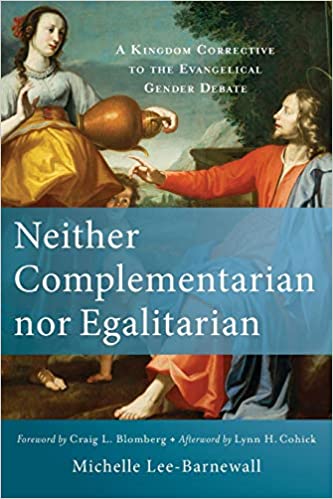
BOOK REVIEW: NEITHER COMPLEMENTARIAN NOR EGALITARIAN
Introduction
An associate professor of biblical and theological studies at Biola University, Michelle Lee-Barnewall is the author of Neither Complementarian nor Egalitarian. She takes a fresh look at the theology of gender in Scripture. Barnewall challenges her readers not to merely align with the egalitarian’s focus on rights or the complementarian’s focus on authority. Rather consider the overarching theme of unity—signified by an other-centered orientation of love—as it relates to men and women.
A second theme in the book is an in-depth look at “reversal” in the community of God. Barnewall noted, “We may gain more not from merely asking what rights a person has or who has power but by seeing why unity matters and how it is accomplished by power manifested through weakness (2 Cor 12:9), such as was exhibited through the cross (p. 7).” Barnewall advocates for reexamining gender in light of kingdom theology. This kingdom theology incorporates love, unity, inclusion, and reversals of power within the body of the church and in marriage.
Book Sections
The author divided the book into two parts. The first part traces the timeline of history. She begins from the first evangelical feminist movement to the Victorian ideal for women in the mid-nineteenth and twentieth century. Then she continues through America’s two world wars, into the 1970’s secular feminist movement and the emergence of egalitarianism. The second part of the book examines the Bible texts in light of kingdom themes for ministry and marriage. Relating both to men and women, Barnewall described the components of the witness of the church. Following Christ’s pattern, the church depends not on rights or leadership privileges, but on unity, holiness, and sacrifice for others.
Framing the Gender Discussion
One goal of the book is to frame the gender discussion in the context of relational inclusion and oneness. These are kingdom values in the example of Jesus. In the body of Christ, inclusion, not equality is valued. In the church, imitating Christ as servant and slave is the model for leaders. Barnewall astutely notes, “As evangelical Christians, we often want to know what we can or cannot do…As the gender debate has concentrated on specific activities, it runs the same risk of creating a theology defined by an external pattern of prohibitions and allowances (p. 12).”
A second goal of the book is to trace the impact of societal social trends on evangelicalism. Its’ move away from seeking the greater good towards its emphasis on individualism and personal fulfillment within the family unit. However, the author acknowledges one drawback in her book: “Unfortunately the limitations of the study also mean that we will not be able to focus on the contribution of working-class or African American women but will study primarily white, middle-class women who figured more prominently in evangelicalism (Footnote, p. 19)…”
Significant Points
To conclude this review, I have provided a list of seven significant points here:
- Jesus’s priority is “the kingdom of God.” And, the author reminds the church, “Theology centers not on people but on God (p. 71)…”
- Unity with God and with one another were Adam and Eve’s deepest needs, not equality. Eve and Adam shared the mandate to rule and subdue (Gen 1:28). Adam was to “leave and cleave” to Eve in spiritual, physical, and emotional unity. Yet, he objectified Eve to God. Adam passed blame. He said, “the woman whom you gave me (Gen 3:12).” Adam had a responsibility to foster unity with Eve. Representing “a critical, but mostly overlooked, aspect of Adam’s failure.” “It is difficult to imagine that “authority” would be the main characteristic of his responsibility since power relationships tend to separate rather than create intimacy (p. 142–3).”
- Scripture points to the kingdom’s values of inclusion. And, the reversal of insiders and outsiders: “the first will be last, and the last first (Mk 10:31).” Barnewall writes, “The principal distinction in regard to discipleship is not male versus female but responding to the gospel versus rejecting the gospel…the inclusion of women as disciples taught…foundational values of the kingdom…The significance of women disciples goes even beyond ‘equality’ and points to the nature of the kingdom built on God’s power and supernatural ways (p. 97).”
- The section titled “The Husband as ‘Head’ in Ephesians 5:21–33” is insightful (ch 5). Barnewall describes the nuances of the head-body metaphor. She writes, “Because the goal of unity is tied so strongly to the actions of the head, the implications of the passage go beyond mutuality and equality…Paul is not speaking of traditional patriarchy being carried out in a sacrificial way; rather he refers to an essential aspect of the husband’s role as “head,” which results in unity (p. 164–5).”
- Exercise caution when using the terms “patriarchal,” “mutuality,” “complementarity,” “feminism,” or “servant leadership.” (p. 170) There are varying ways to define each. And these terms can lead to misunderstanding and confusion.
- It matters how we frame the gender debate. It matters what questions we ask. And, with what attitudes and perspectives we approach the Scriptures. The book’s central premise is: “The crucial component to reframing the debate is to consider God’s purposes for his people and how these are accomplished in the new age (p. 167).” We must keep the focus on God, reflect God’s holiness and grace, and seek others’ good.
Conclusion
Women in the early church contributed significantly to spreading the message of Christ. The Afterword author, Lynn Cohick said, “As I explore Christian women’s lives in the early centuries, I am repeatedly struck by the importance of the faithful discipleship—even to the point of martyrdom—that trumped their identity as women (p. 180).” I highly recommend this book to anyone interested in exploring the intersection of women, authority, and the Bible.